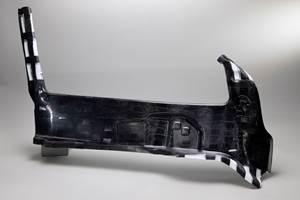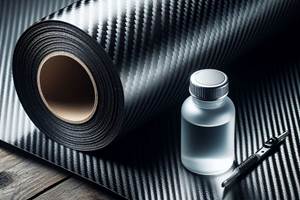Not your average carbon fiber part
A Swedish industrial designer and artisan, Ragnar Friberg, contacted CW recently about a new project: a one-of-a-kind custom champagne glass and an accompanying storage cabinet that incorporates carbon fiber — along with a number of high-end materials.

This exclusive champagne glass and protective cabinet, incorporating carbon fiber/epoxy, comes from Swedish designer Ragnar Friberg.
A Swedish industrial designer and artisan, Ragnar Friberg, contacted CW recently about a new project: a one-of-a-kind custom champagne glass and an accompanying storage cabinet that incorporates carbon fiber — along with a number of high-end materials including diamonds, gold, porphyry stone and black oak wood from the 15th Century. The founder of the design firm RAF (Stockholm), Friberg tells us that his years of experience with composites in power boat racing, where he constructed his own boats, led him to eventually build a business where he combines carbon fiber with other fine materials to make beautiful, exclusive yet useful articles.
Friberg envisioned a 305 mm-tall champagne flute with a carbon fiber/epoxy cup combined with a gold stem ornamented with inlays, on an 18K solid gold base. The entire glass weighs 190 grams, with the base weighing 100 grams, “to balance the cup when it’s been filled with champagne,” says Friberg. He explains that the cup was made with 6 plies of a 1k 2x2 woven twill, 150 grams per square meter (gsm) and 1 mm thick, with the fabric supplied by textile weaver C. Cramer & Co. (Heek, Germany). The fabric was wet out with an epoxy supplied by Huntsman Advanced Materials (The Woodlands, TX, US). Friberg explains that he rejected prepreg because “It looked too perfect, too sterile. I wanted to add a blue color to the epoxy resin, so that the cured cup and stem inlays would be faintly blue.” The biggest challenge was applying the gold leaf. After wetting the first ply with resin, he placed the gold leaf onto the wet-out fabric on a vacuum table, he explains: “I had to get the gold leaf to really sink into the fiber weave, and the vacuum helped in that regard.” Placing the gold-treated ply in the mold was also tricky, to avoid air entrapment and cracking of the very thin gold layer. After nearly 100 attempts to get the gold layer as he wanted it, Friberg says he switched to an epoxy with higher flexibility, which prevented cracking in the gold. To ensure the integrity of the gold/carbon bond, the cup was molded in two halves, with the inner 3 plies (including the gold) molded around an conical aluminum mandrel, and the outer three plies placed in a matching female mold. The entire layup was oven-cured at 60°C for 16 hours.

The cup is supported by four gold legs, which dovetail into the stem, which has carbon fiber inlays.
After demolding, the cup halves were bonded together (with seams offset by 90°), and the cup was sanded, clear-coated and polished. The photos show how the bottom of the cup is finished with an adhesively-bonded cast gold cone. Four thin, solid gold legs were glued to the cup’s exterior; the legs extend down past the cone to the square stem, where they are attached via dovetailed slots. The stem combines more carbon/epoxy, 15th Century black oak and lizard skin inlays over solid 18K gold; the stem in turn is fastened to the gold base with 4 gold screws. Three diamonds totalling 2.09 carats are part of the flute, including one that is set inside the cup at the bottom. Says Friberg, ”The diamond inside stimulates the champagne bubbles and boosts the bouquet.”

The cup is made with a 1K carbon twill, with gold leaf applied to the cup's inner surface before cure.
The hefty 8 kg, 450 mm-high cabinet exists to hold and protect the glass. It is a combination of gold, porphyry stone, lizard skin and silk. All together, Friberg estimates that more than 1000 hours have gone into making the glass and cabinet, which, when offered to the market, will command approximately $120,000. When asked what motivates his work, Friberg says that he got interested in composites in the 1990s and has been working on projects that would showcase carbon fiber ever since: “I came up with the idea to make something really nice — to make a truly beautiful thing is worth trying.” Friberg's web site () has more photos and other products as well.
Related Content
Highly tunable, woven lattice reinforcements target automotive structures
CAMX 2023: Startup Weav3D will be demonstrating its two collaborative automotive demonstrator parts and present two conference papers.
Read MoreAerospace prepregs with braided reinforcement demonstrate improved production rates, cost
A recent time study compares the layup of a wing spar using prepreg with A&P’s TX-45 continuous braided reinforcement versus traditional twill woven prepreg.
Read MoreComposite resins price change report
CW’s running summary of resin price change announcements from major material suppliers that serve the composites manufacturing industry.
Read MoreTechnical textiles, prepregs, composite parts and multilayered materials
CAMX 2025: BGF Industries is highlighting its range of versatile woven products for composite reinforcements, with materials, parts and literature available for viewing, as well as those from parent company Porscher Industries.
Read MoreRead Next
Cutting 100 pounds, certification time for the X-59 nose cone
Swift Engineering used HyperX software to remove 100 pounds from 38-foot graphite/epoxy cored nose cone for X-59 supersonic aircraft.
Read MoreCeramic matrix composites: Faster, cheaper, higher temperature
New players proliferate, increasing CMC materials and manufacturing capacity, novel processes and automation to meet demand for higher part volumes and performance.
Read MoreNext-gen fan blades: Hybrid twin RTM, printed sensors, laser shock disassembly
MORPHO project demonstrates blade with 20% faster RTM cure cycle, uses AI-based monitoring for improved maintenance/life cycle management and proves laser shock disassembly for recycling.
Read More









